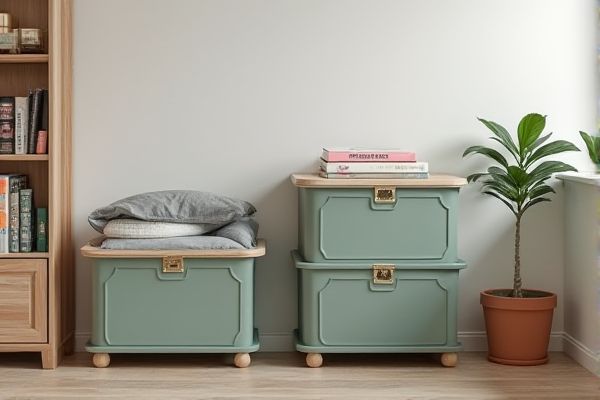
Foldable storage bins offer the advantage of space-saving convenience when not in use, easily collapsing flat for storage, while stackable storage bins maximize vertical space with sturdy designs that support piling. To decide which option best suits your organization needs, explore the detailed comparison in the rest of this article.
Table of Comparison
| Feature | Foldable Storage Bin | Stackable Storage Bin |
|---|---|---|
| Design | Collapsible, folds flat for easy storage | Rigid, designed to stack securely on top of each other |
| Material | Often fabric or lightweight plastic | Durable plastic or metal for stability |
| Storage Capacity | Varies; flexible shape allows slight adjustment | Fixed volume, optimized for maximized stacking |
| Space Saving | High; folds flat when not in use | Moderate; requires permanent space when stacked |
| Weight | Lightweight and portable | Heavier due to solid construction |
| Durability | Less durable, suitable for light storage | Highly durable, ideal for heavy-duty storage |
| Best Use | Temporary or flexible storage needs | Long-term organization and heavy item storage |
Introduction to Foldable and Stackable Storage Bins
Foldable storage bins offer versatile space-saving solutions ideal for seasonal storage or small living areas, as they collapse flat when not in use. Stackable storage bins provide efficient organization by maximizing vertical space with sturdy, interlocking designs that support heavy loads. Choosing between foldable and stackable storage bins depends on your storage needs, balancing portability and durability for optimal home or office organization.
Key Features of Foldable Storage Bins
Foldable storage bins feature collapsible sides made from flexible materials like fabric or mesh, allowing easy folding and compact storage when not in use. These bins often include reinforced frames for stability, handles for portability, and lightweight designs suitable for versatile organization in small spaces or while traveling. Their adaptability and space-saving benefits distinguish them from rigid, stackable storage bins designed primarily for fixed stacking and heavy-duty use.
Key Features of Stackable Storage Bins
Stackable storage bins feature rigid walls and interlocking lids designed to maximize vertical space efficiency by securely stacking on top of each other. These bins often include built-in handles, clear or labeled sides for easy identification, and durable materials such as heavy-duty plastic to withstand heavy loads. Your storage system benefits from enhanced stability and accessibility, making stackable bins ideal for organized garages, warehouses, or closets.
Space Efficiency Comparison
Foldable storage bins maximize space efficiency by collapsing flat when not in use, making them ideal for saving room in small areas or during seasonal storage. Stackable storage bins provide vertical space optimization by allowing you to safely pile multiple bins, which helps keep your storage area organized without sacrificing accessibility. Your choice depends on whether you prioritize compact storage when empty or efficient use of vertical space when filled.
Material and Durability Differences
Foldable storage bins are typically made from fabric materials like polyester or canvas, offering lightweight flexibility but less rigidity and durability under heavy loads. Stackable storage bins are often constructed from hard plastics such as polypropylene, providing superior strength, impact resistance, and the ability to securely support weight when stacked. Choosing the right bin depends on your need for portability versus long-term durability and load-bearing capacity.
Portability and Ease of Use
Foldable storage bins excel in portability due to their lightweight design and ability to collapse flat, making them easy to carry and store when not in use. Stackable storage bins offer superior ease of use by providing stable, organized storage with interlocking features that maximize space efficiency. Choosing between the two depends on whether mobility or structured storage is the primary need.
Storage Capacity and Versatility
Foldable storage bins offer flexible storage capacity by collapsing when not in use, saving space without sacrificing volume when expanded, making them ideal for varying storage needs. Stackable storage bins maximize vertical space with a fixed capacity, providing stable and efficient organization, especially in warehouses or closets with limited floor area. Both types enhance versatility, but foldable bins adapt better to intermittent storage demands, while stackable bins excel in consistent, high-density storage setups.
Organizational Benefits for Home and Office
Foldable storage bins offer versatile organizational benefits by allowing easy collapse and storage when not in use, maximizing space efficiency in both home and office environments. Stackable storage bins provide stable, vertical storage solutions that optimize limited floor space and enhance accessibility for frequently used items. Choosing between foldable and stackable bins depends on the need for portability versus permanent, space-saving organization.
Cost and Value Considerations
Foldable storage bins generally offer greater cost efficiency due to their collapsible design, which reduces shipping and storage expenses when not in use. Stackable storage bins, while often pricier upfront, provide increased durability and space optimization, delivering long-term value for organized environments. Choosing between the two depends on budget constraints and the need for either portability or structural stability in storage solutions.
Conclusion: Choosing the Right Storage Bin for Your Needs
Foldable storage bins offer space-saving benefits with easy collapsibility for seasonal or temporary storage, making them ideal for flexible organization. Stackable storage bins provide durability and efficient vertical storage, suitable for maximizing permanent storage space in garages or warehouses. Selecting the right option depends on whether portability and compact storage or sturdiness and maximized stacking capacity best meet your organizational needs.
 homyna.com
homyna.com